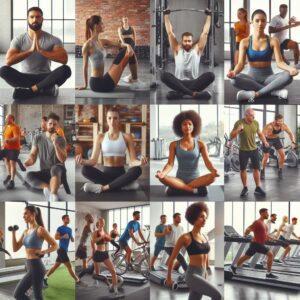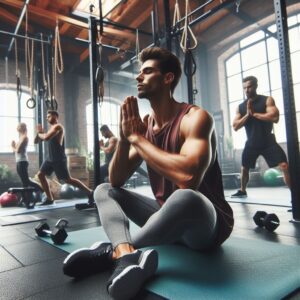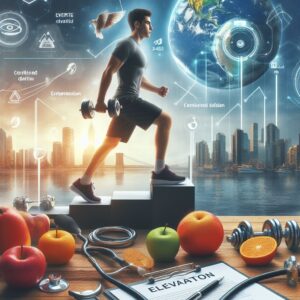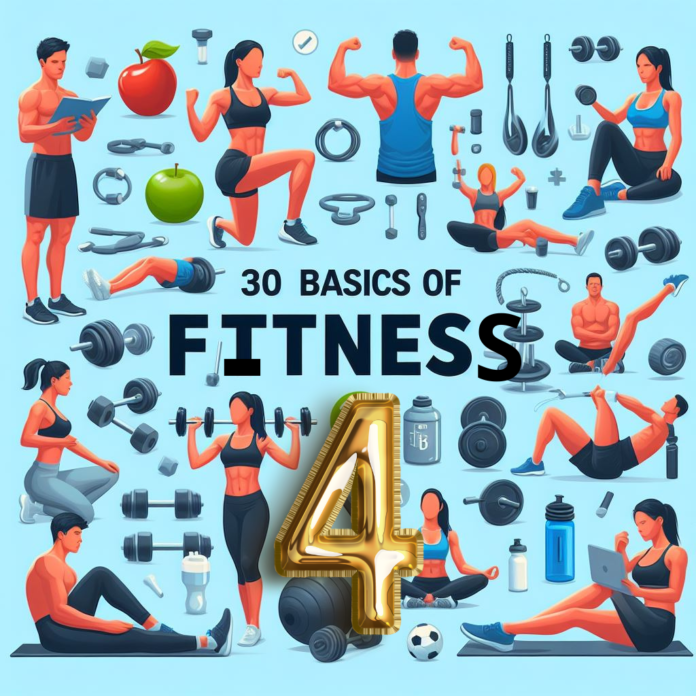In today’s fast-paced world, embarking on a fitness journey is a commitment that demands not only physical effort but also mental resilience and strategic planning. “The 30 Basics of Fitness: A Complete Guide for Beginners” is designed to provide newcomers with a comprehensive roadmap, ensuring a well-rounded approach to health and wellness.
From embracing the dynamism of varied workout routines to the integration of cutting-edge technology and the wisdom of active rest, this guide underscores the importance of continued education, patience, perseverance, and the power of celebrating every progress. Each section is meticulously crafted to foster a deeper understanding of the multifaceted nature of fitness, offering valuable insights that pave the way for a successful and sustainable fitness journey.
I. Embracing Diversity in Your Fitness Routine:

The adage that variety is the spice of life extends far beyond the culinary realm, permeating the very essence of a successful fitness journey. Incorporating diversity into your workout regimen is not merely a suggestion; it is a pivotal strategy for those seeking to enhance their physical fitness and overall well-being. This comprehensive approach involves a deliberate shift from monotonous, repetitive routines to a rich tapestry of exercises and activities, offering profound benefits that can revolutionize your fitness experience.
1. Why Variety Matters in Fitness?
-Combatting Workout Monotony:
One of the most significant challenges in maintaining a consistent fitness routine is the sense of tedium that can arise from repetitive exercise. When workouts become predictable, the initial excitement and engagement can quickly wane, leading to decreased motivation and adherence. By infusing your regimen with a range of activities, you rekindle the spark of enthusiasm, making each session an opportunity for discovery and enjoyment.
-Boosting Motivation:
The psychological impact of variety cannot be overstated. New challenges and experiences stimulate the brain, keeping motivation at peak levels. This is crucial for sustaining a long-term commitment to fitness goals, as it ensures that the journey remains engaging and rewarding.
-Encouraging Comprehensive Physical Development:
A diverse workout regimen addresses the body’s various needs, promoting balanced growth and development. Alternating between cardio, strength training, flexibility exercises, and interval training ensures that no muscle group is neglected. This holistic approach not only enhances overall fitness but also minimizes the risk of injuries by preventing the overuse of specific muscles.
-Preventing Plateaus:
The human body is remarkably adaptable, quickly becoming efficient at performing familiar tasks. This adaptability, while beneficial for survival, can lead to fitness plateaus, where progress stalls despite continued effort. By constantly introducing new exercises and activities, you challenge your body in novel ways, forcing it to adapt and improve. This is key to achieving continuous progress and avoiding the frustration of stagnation.
-Exploring New Horizons:
The pursuit of variety often leads to the discovery of new passions and interests. Whether it’s engaging in team sports, exploring outdoor activities, or experimenting with different styles of dance, the quest for diversity can enrich your life far beyond the confines of the gym. This openness to new experiences not only enhances physical fitness but also contributes to personal growth and fulfillment.
2. Implementing Variety in Your Routine:
Incorporating variety into your fitness regimen requires a strategic approach. Start by assessing your current routine to identify areas of monotony. From there, explore activities that contrast with your usual exercises, whether that means adding yoga to a weightlifting-focused routine or incorporating sprints into a predominantly endurance-based program. Consider engaging with fitness communities, either locally or online, to discover new activities and draw inspiration from others. Remember, the goal is not to overhaul your entire routine overnight but to introduce changes gradually, allowing your body and mind to adjust and embrace the new challenges.
The integration of variety into your fitness regimen is a powerful catalyst for physical and psychological growth. By embracing diversity in your workouts, you not only prevent boredom and foster motivation but also pave the way for a more balanced and fulfilling fitness journey.
II. Leveraging Technology for Enhanced Fitness Outcomes:

The fusion of technology with fitness regimes has transformed the landscape of personal health and wellness. This integration has paved the way for a more informed, interactive, and engaging fitness experience. Leveraging technology, from sophisticated wearable devices to comprehensive mobile applications and interactive online platforms, empowers individuals to take charge of their fitness journey with unparalleled precision and personalization. This strategic embrace of technology can significantly amplify the effectiveness of your fitness routine, offering a myriad of benefits that cater to the diverse needs and goals of users.
1. The Role of Technology in Fitness:
-Advanced Tracking and Analytics:
Modern fitness apps and wearable devices offer a wealth of data, from tracking daily steps and heart rate to monitoring sleep patterns and exercise intensity. This real-time feedback allows for a detailed understanding of your physical activities and health metrics, facilitating a tailored approach to fitness that can adjust to your body’s needs and the progress you are making.
-Nutritional Guidance:
Nutrition plays a crucial role in achieving fitness goals, whether it’s weight loss, muscle gain, or maintaining a healthy lifestyle. Technology offers access to a plethora of nutritional tracking apps and platforms, enabling users to monitor their dietary habits closely. These tools can provide personalized meal plans, calorie tracking, and nutritional insights, making it easier to align your diet with your fitness objectives.
-Wearable Devices:
Smartwatches and fitness trackers have become indispensable tools for fitness enthusiasts. These devices not only track physical activity and health metrics but also offer insights into performance trends and recovery needs. With features like GPS tracking for runners, swim-proof designs for swimmers, and heart rate monitoring for all types of exercises, wearable technology supports a broad range of fitness activities.
-Online Fitness Communities and Platforms:
The rise of online fitness platforms has democratized access to professional training and advice. These platforms offer a variety of workout programs, from high-intensity interval training (HIIT) and yoga to specialized regimes like pilates and strength training, often guided by expert instructors. Moreover, the social features of these platforms foster a sense of community, providing motivation and support from peers and coaches alike.
-Virtual and Augmented Reality Experiences:
The cutting-edge realms of virtual (VR) and augmented reality (AR) are beginning to make their mark on fitness, offering immersive workout experiences that combine entertainment with exercise. VR fitness games and AR workout guides project digital environments and interactive elements into your training, making workouts more engaging and fun.
2. Implementing Technology in Your Fitness Routine:
To effectively integrate technology into your fitness routine, start by identifying specific goals and needs. For example, if improving cardiovascular health is your priority, a heart rate monitor and a tracking app focusing on cardio exercises would be beneficial. For those focusing on nutrition, apps that offer detailed food tracking and meal planning might be more appropriate.
Next, explore and experiment with different tools and platforms to find what best suits your preferences and lifestyle. It’s important to choose user-friendly technology that seamlessly integrates into your daily routine, ensuring consistency and long-term engagement.
Lastly, stay updated on the latest trends and advancements in fitness technology. The digital health field is rapidly evolving, with new devices, apps, and online platforms constantly emerging, offering new opportunities to enhance your fitness experience.
Technology stands as a pivotal ally in the quest for fitness and wellness, offering tools that enrich the workout experience, provide valuable insights, and foster motivation. By judiciously incorporating technology into your fitness regimen, you can unlock a more efficient, enjoyable, and effective path to achieving your health and fitness goals.
III. The Power of Active Rest in Your Fitness Journey:

The concept of active rest emerges as a cornerstone, balancing the rigorous demands of workout routines with the essential need for recovery. Active rest, characterized by engaging in low-intensity physical activities on rest days, plays a pivotal role in enhancing muscle recovery, maintaining momentum in your exercise routine, and ensuring your body isn’t overwhelmed by excessive strain. By integrating active rest into your fitness regimen, you not only support your body’s recovery processes but also contribute to a well-rounded and sustainable approach to health and wellness.
1. Understanding Active Rest:
-Promoting Muscle Recovery:
Active rest aids in alleviating muscle stiffness and promoting blood circulation. Engaging in light physical activity increases blood flow to the muscles, delivering essential nutrients and oxygen that support the healing and rebuilding process. This can lead to more efficient recovery and reduce the risk of injury, enabling you to return to your regular workouts with renewed strength and vitality.
-Maintaining Exercise Momentum:
Incorporating active rest days helps preserve the habit of regular physical activity, making it easier to stick to your fitness goals in the long run. It prevents the loss of momentum that can occur during complete rest days, helping you stay in the rhythm of your workout routine without imposing significant physical stress on your body.
-Psychological Benefits:
Beyond the physical advantages, active rest has notable psychological benefits. It offers a mental break from the intensity of regular workouts while allowing you to stay active and engaged with your fitness goals. This balance can help prevent burnout and maintain a positive and motivated mindset towards exercise.
2. Effective Active Rest Activities:
-Walking:
A simple yet profoundly beneficial activity, walking on your rest days provides gentle cardiovascular exercise without straining your muscles. It’s accessible, requires no special equipment, and can be enjoyed anywhere, making it an ideal option for active rest.
-Gentle Yoga:
Yoga, especially styles focusing on flexibility and relaxation like Hatha or Yin Yoga, can be an excellent way to engage in active rest. It helps in stretching tight muscles, improving mobility, and offering a peaceful space for mental relaxation and mindfulness.
-Low-Intensity Cycling:
Cycling at a gentle pace, either outdoors or on a stationary bike, is another suitable active rest activity. It keeps the legs moving and the blood flowing with minimal impact on the joints and muscles, promoting recovery while enjoying the benefits of aerobic exercise.
3. Incorporating Active Rest into Your Routine:
To effectively incorporate active rest into your fitness plan, listen to your body and choose activities that you enjoy and find relaxing. The goal is to engage in light movement that feels rejuvenating rather than exhausting. Schedule active rest days strategically, especially after intense workout sessions or when you notice signs of fatigue. Remember, the purpose of active rest is to complement your fitness journey, not to compete with it.
Active rest is a critical component of a balanced fitness regimen, offering numerous benefits that support physical recovery, psychological well-being, and overall fitness progress. By thoughtfully integrating active rest activities into your routine, you embrace a more holistic approach to health, ensuring that your journey toward fitness is not just about how hard you work but also about how well you recover.
IV. Elevating Your Fitness Journey Through Continued Education:

The pursuit of knowledge stands as a powerful tool in achieving and maintaining optimal well-being. Continued education in fitness, nutrition, recovery methods, and overall health empowers individuals with the insights and understanding necessary to make informed decisions that can significantly impact their health journey. This commitment to learning goes beyond casual interest, representing a strategic investment in one’s well-being that can lead to more effective workouts, improved nutritional choices, enhanced recovery, and a deeper appreciation for the nuances of personal health.
1. The Importance of Continued Education in Fitness:
-Making Informed Decisions:
With a solid foundation of knowledge, you’re better equipped to sift through the vast amounts of information available in the fitness world, distinguishing between evidence-based practices and fleeting trends. This enables you to make choices that are aligned with your personal health goals and based on reliable information.
-Personalizing Your Fitness Plan:
Understanding the principles of exercise science and nutrition allows for a more tailored approach to fitness. By recognizing how different strategies affect your body, you can customize your workout and diet plan to suit your unique needs, preferences, and objectives, leading to more effective and enjoyable health routines.
-Staying Motivated and Engaged:
Learning new concepts and techniques can reinvigorate your interest and enthusiasm for fitness. This continuous injection of fresh ideas and practices helps to prevent boredom and stagnation, keeping you motivated and engaged in your health journey.
-Promoting Long-term Health:
Continued education in health and fitness contributes to a more comprehensive approach to well-being, emphasizing prevention and long-term health rather than quick fixes. This perspective encourages sustainable lifestyle changes that can improve quality of life and well-being over time.
2. Ways to Engage in Continued Fitness Education:
-Reading Books and Research Studies:
Dive into the wealth of knowledge found in books, academic journals, and research studies focusing on health, fitness, and nutrition. This can provide a deep understanding of the science behind fitness practices and health recommendations.
-Following Reputable Blogs and Websites:
Many fitness professionals, nutritionists, and health experts share valuable insights through blogs and websites. Choose reputable sources that rely on evidence-based information to stay updated on the latest trends, tips, and discoveries in the field.
-Attending Workshops and Seminars:
Participating in workshops, seminars, and conferences offers an opportunity to learn from experts in the field. These events can also be a great way to network with fellow fitness enthusiasts and professionals, fostering a community of learning and support.
-Enrolling in Online Courses:
With the rise of digital education platforms, there are countless online courses available covering every aspect of fitness and health. These courses range from beginner to advanced levels, offering flexibility and accessibility to learners at any stage of their fitness journey.
3. Implementing What You Learn:
To maximize the benefits of your continued education efforts, apply what you learn to your daily routine. Experiment with new exercises, dietary strategies, and recovery techniques, and monitor how they affect your performance and well-being. Remember, the goal of education is not just to accumulate knowledge, but to use that knowledge to enhance your life and health.
Embracing continued education in health and fitness is a pivotal step in cultivating a more informed, effective, and fulfilling approach to personal well-being.
V. Cultivating Patience and Perseverance for Lasting Fitness Success:

The virtues of patience and perseverance cannot be overstressed. The path to physical transformation and improved well-being is often long and filled with challenges. Recognizing that significant results in fitness and health do not manifest overnight is crucial. This understanding fosters a mindset of patience and perseverance, essential ingredients for long-term success. Embracing these qualities ensures that you remain steadfast in the face of adversity, leading to sustainable changes that benefit your health and overall quality of life.
1. Understanding the Importance of Patience in Fitness:
-Realistic Expectations:
Setting realistic goals and timelines is foundational in maintaining motivation and commitment. Understanding that the body needs time to adapt and change helps in tempering expectations and appreciating the incremental progress made.
-Embracing the Process:
Fitness is a journey, not a destination. Patience allows you to embrace the process of getting fit, finding joy in the daily routines, and celebrating the small victories along the way. This perspective shifts the focus from merely achieving goals to enjoying the journey, enhancing the overall experience.
-Preventing Burnout:
Patience helps in pacing yourself, ensuring that you don’t push too hard too fast, which can lead to burnout or injury. It encourages a balanced approach to fitness, integrating rest and recovery as essential components of your routine.
2. The Role of Perseverance in Achieving Fitness Goals:
-Overcoming Setbacks:
Challenges and setbacks are inevitable in any fitness journey. Perseverance equips you with the resilience to face these obstacles head-on, learn from them, and continue moving forward toward your goals.
-Consistency Over Perfection:
Perseverance is about consistency—not perfection. It’s about showing up for your workouts even on days when you’re not at your best, maintaining your commitment to healthy eating even when temptations arise, and steadily working towards your goals despite the ups and downs.
-Long-term Success:
The most profound transformations in fitness come from sustained effort over time. Perseverance ensures that you stay the course, leading to lasting changes in your physical health, mental well-being, and overall lifestyle.
3. Strategies for Cultivating Patience and Perseverance:
-Setting and Celebrating Milestones:
Break your long-term goals into smaller, manageable milestones. Celebrating these achievements can provide motivation and a sense of progress, reinforcing your commitment to the journey.
-Mindfulness and Reflection:
Practice mindfulness and reflect on your journey. Acknowledge the effort you’re putting in, the obstacles you’ve overcome, and the growth you’ve experienced. This reflection can bolster your resolve and help maintain focus on your goals.
-Support Systems:
Lean on a support system of friends, family, or a fitness community. Sharing your struggles and successes with others can provide encouragement, advice, and accountability, helping you stay on track even when the going gets tough.
Patience and perseverance are the bedrock upon which lasting fitness success is built. They empower you to navigate the inevitable challenges and setbacks with grace, maintain focus on your long-term goals, and appreciate the journey towards improved health and well-being.
VI. Celebrating Every Progress: The Keystone of Fitness Motivation:

Acknowledging and celebrating every stride made on your fitness journey, no matter how minor it seems, stands as a powerful catalyst for sustained motivation and enhanced self-esteem. This practice of recognizing each accomplishment, from reaching a new fitness milestone to noticing improvements in endurance, or even maintaining consistency in your routine, is vital. Celebrating progress not only serves as a reminder of how far you’ve come but also fuels your drive to continue pushing forward. Let’s delve deeper into the multifaceted benefits of celebrating progress and how it can enrich your fitness experience.
1. The Psychological Impact of Celebrating Progress:
-Boosting Motivation:
Recognizing achievements triggers the release of dopamine, a neurotransmitter associated with feelings of pleasure and satisfaction. This biochemical response not only enhances mood but also reinforces the behavior that led to the achievement, thereby boosting motivation to maintain or increase efforts.
-Building Self-Esteem:
Celebrating your progress, regardless of its scale, contributes to a positive self-image. Each celebration is an acknowledgment of your capability and hard work, which can significantly bolster self-esteem and confidence in your ability to achieve future goals.
-Overcoming Plateaus:
Fitness journeys often encounter plateaus, where progress seems to stall. Celebrating even the smallest progress during these times can provide a much-needed psychological lift, helping to maintain focus and perseverance.
2. Ways to Celebrate Fitness Progress:
-Set Personal Rewards:
Create a system of rewards that correspond to different milestones. For example, treat yourself to a massage after reaching a specific running distance, or a new workout gear for consistent workout attendance over a month. Ensure these rewards support your fitness goals and offer personal satisfaction.
-Share Your Success:
Sharing your achievements with friends, family, or a fitness community can amplify the joy of your success. Social acknowledgment not only provides external validation but also strengthens your support network, encouraging continued effort and accountability.
-Reflective Journaling:
Maintain a fitness journal to document your journey. Regularly reflecting on your progress and noting down new achievements can be incredibly rewarding. This practice not only allows you to see how much you’ve achieved over time but also helps in identifying patterns and areas for future improvement.
-Visual Progress Trackers:
Use visual tools like progress photos, fitness apps, or milestone charts to track and celebrate your achievements. Visual evidence of how far you’ve come can be incredibly motivating and a tangible reminder of your hard work and dedication.
3. Integrating Celebration into Your Fitness Routine:
To effectively integrate celebration into your fitness journey, set clear, measurable goals from the outset and decide in advance how you will celebrate achieving them. This preparation not only gives you something to look forward to but also helps to keep your eyes on the prize, making the journey more enjoyable and motivating.
Additionally, practice gratitude for what your body can achieve. This mindset shift towards appreciation can transform your fitness journey from a series of tasks into a rewarding and an enriching experience, where every progress, no matter how small, is a cause for celebration.
Celebrating every progress made on your fitness journey is a crucial strategy for maintaining motivation, building self-esteem, and fostering a positive and resilient mindset. By acknowledging and celebrating each step forward, you not only enjoy the journey more but also set the stage for achieving long-term success and well-being.
Conclusion:
As we conclude our exploration of “The 30 Basics of Fitness,”(part 4) it’s clear that achieving fitness goals extends beyond mere physical activity. It involves nurturing a mindset geared towards growth, resilience, and a positive outlook. The journey of fitness is as much about evolving one’s lifestyle and habits as it is about physical transformation. Embracing the diversity of routines, leveraging technology for enhanced outcomes, and understanding the significance of active rest, committing to continuous learning, and cultivating patience and perseverance are not just steps but milestones in their own right. Moreover, recognizing and celebrating every bit of progress acts as a constant fuel for motivation, driving us towards our goals with a renewed sense of purpose. As you embark on or continue your journey, let this guide serve as a beacon, illuminating the path to a healthier, happier, and more fulfilled you.

